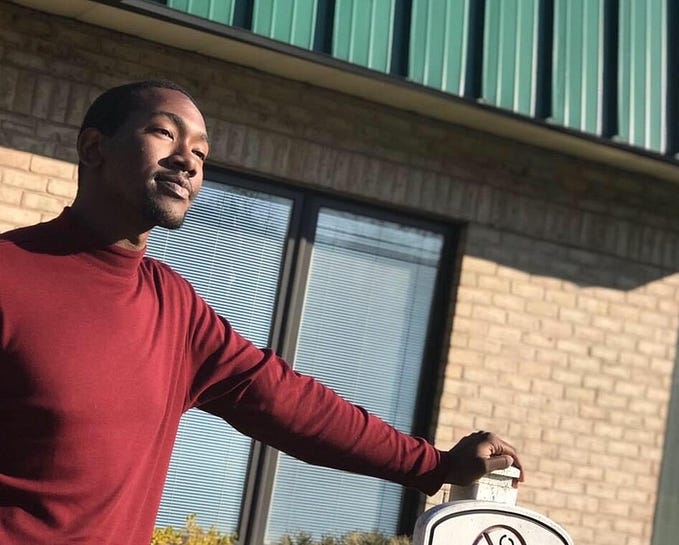Sunken Place Symptoms: A Guide to Pro-Black vs Anti-Black POC

There is something very magical that happens when there is more than one Black person in a predominantly white space. I may never have met any of them before, but, as soon as a particularly white™ transgression occurs, I’ve witnessed the room’s Black population collectively enter a higher plane of existence through a single look. It is a very classic “look”. It’s like we all switch our brains to a different wavelength and have a silent forum discussion, all while the white population remains unaware. (The discussion usually starts with, Are y’all seeing this, too? What the f*ck...)
Similar to “the nod” — made famous in popular modern culture by the sitcom “Black-ish” — the “look” serves a dual purpose. In an age where anti-Black Black people have garnered media platforms, it is a way to quickly vet whether or not to place your trust in a new person. It is a tool for safe communication in an unsafe space, while also confirming the pro-Black politics of the other Black people present (and sometimes the non-Black POC).

Even in times of quarantine, when nobody is in the same room together, social media has continued to innovate “the look” through platforms like Ziwe Fumudoh’s Instagram lives. She has garnered attention recently through her interviews on race with controversial public figures. When her subject says something questionable, Ziwe widens her eyes looking directly at her audience and approaches the camera, much to the confusion of the speaker. It is remarkable how even through a screen, through time and space, “the look” prevails as I find myself widening my eyes back at Ziwe in silent agreement — whether over Caroline Calloway or Jeremy Harris. People continue to perform allyship for Black Lives on social media and BIPOC continue to agree that we see right through the performance — we just know the performative language when we see it. Perhaps, considering Black people have had a lot more practice navigating an endless minefield of racial transgressions, it is understandable that white people have not had to develop this same crucial survival skill.
With the rise of the 2020 Fed-Up Reckoning, a lot of white allies are attempting to re-educate themselves. So, here’s a quick lesson: Diverse representation by itself is not a sustainable solution to racism and white supremacy. Why? In the words of Tracey Corder of Black Womxn For,
“Just saying ‘Oh, a Black person is there. We won,’ is actually not okay and not enough. We actually have to talk about how we want that person to show up.”
We have done diversity in high places for decades (lest you forget our previous U.S. President, Ben Carson, Omarosa Newman, or the already diverse demographics of police in some cities). It’s tired, it has led to very little change, and it does nothing to dismantle a racist structure. Don’t be fooled by the allure of diverse representation — it is the bare minimum. Being Black or a POC does not make you immune from participating in white supremacy. It seems like an obvious point laid out perfectly in the “sunken place” memes born from the 2017 film Get Out. “The Sunken Place is a new term we have to aid us in the discussion of what appears, to me, to be Black people choosing an ideology that is racist against Black people,” Peele stated in a Complex interview.
Though your Blackness lets me know that you’ve experienced a form of discrimination that I might relate to, it tells me nothing about your pro-Black policies. It can be jarring to encounter an anti-Black POC, but it does happen. Every time a white person in power parades a new Black person or POC that they have placed in an authoritative position, many Black people (me, I am many Black people) instantly vet them for “sunken place” symptoms or signs that they are aligned with the patriarchal white supremacist system. Here are some red flags to look out for:

Stage One Sunkenness
- Myth of Freedom through Capitalism — speaks about BIPOC needing more financial literacy/BIPOC-owned businesses as a way to “break themselves free”
- Respectability Politics — “We need to be respectable and present ourselves in the best way possible” or “If you look bad, you’ll make us all look bad”
- Racism clichés — “I don’t care if you’re Black, white, or purple.” or “I don’t care your race, religion, or creed.”
Stage Two Sunkenness
- The Jester — Makes jokes at their own expense when in the company of white peers
- Anti-Mentorship — Refuses to be a mentor or advisor to younger Black people. Maybe suggests others should figure it out like they did.
- Does not participate in “the nod” or “the look”
- Aversion to Rap & Hip-hop — “Rap is the most harmful thing to Black people in America today.” or “Rap music is why our children do drugs and become strippers.”
Stage Three Sunkenness (critical condition)
- Bootstrap Mentality — “Black/POC just need to work harder & pull themselves out of poverty and oppression.”
- Couple of bad apples — Praises the police and refuses to acknowledge police brutality/discrimination
- It’s Not About Race — “[Insert social issue] is not a race thing. Not everything is a race thing. Black people need to stop complaining.”
- Praises Donald Trump (or known racist figures, sex offenders, or rapists)
- Displays their own xenophobia, homophobia, and/or misogyny
- “Slavery wasn’t that bad” or “Slavery was a choice” (see Kanye West, king of the sunken place)






